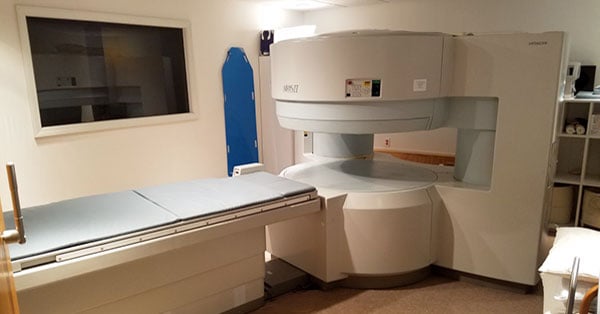
Technology marches on but, with their low maintenance costs, high reliability, and proven track records across a wide install base, older models like the Hitachi Airis Elite and the GE Ovation continue to enjoy a strong worldwide market. If that's a market you find yourself in right now, you might be wondering how best to make a decision between the two.
The comparison below brings some clarity to the open MRI selection process with a side-by-side feature comparison of the Hitachi Airis Elite and the GE Ovation open MRI scanners.
Airis Elite vs. Ovation
What's the same?
The Airis Elite and the Ovation have a lot in common in terms of the benefits they offer. Like other open MRI models, they have a lower cost of operation and service than standard 1.5T MRI scanners. They have permanent magnets, which means no cryogens. Their open design accommodates larger patients as well as patients who suffer from claustrophobia in a closed MRI bore. They also use phased array coils, which give them advantages in scan time, signal, and coverage over scanners using single-channel coils.
On the other hand, they both share some of the same drawbacks. Like other open MRI models, they have a lower magnetic field, resulting in a lower signal to noise ratio, which results in longer scans. Part of this is compensated for with phased array coils, but scans are still not likely to be as fast as scans performed on many standard 1.5T systems.
The permanent magnets used in both of these systems also make them significantly heavier than standard scanners. Depending on the construction of the intended facility, it may be necessary to reinforce or provide additional support.
Open MRI System Weight Comparison
A final element of similarity that's well worth mentioning is pricing. Both models occupy the same relative price bracket around $195,000 for system, delivery, installation, and warranty.
Advantage: Hitachi Airis Elite
Reliability
I don't hesitate to say that the Airis Elite is one of the most worry-free systems sold. In general, the model is very low-maintenance, so much so that many owners choose time and materials service coverage over more comprehensive plans.
Gradient power
The gradients of the Airis Elite are higher-powered with a slew rate of 55, versus 25-46 for the Ovation.
Parts availability (worldwide)
While parts for the Ovation are widely available in the US, the Airis trumps it worldwide due to a larger overall install base.
Younger equipment
In general, Airis Elite systems have more recent dates of manufacture than Ovations, which were brought to market a few years prior.
Weight
At approximately 34,000 pounds, the Airis Elite is about 10,000 pounds lighter than the Ovation.
Hitachi Airis Elite vs. Hitachi Airis II
Advantage: GE Ovation
Magnet strength
The Ovation edges out the Airis Elite slightly in magnet strength at .35T versus .3T. Along with the Siemens Magnetom C, the Ovation features one of the highest field strengths on the market for a permanent magnet- third place, just behind Hitachi's Aperto, whose magnet weighs in at .4T, and the FONAR .6T stand-up MRI.
Parts Availability (USA)
As with most GE Healthcare systems, if you operate in the USA, parts and independent service options for the Ovation are readily available.
The Takeaway
Depending on your most important needs and the location of your facility, either one of these systems could be a good fit for serving your patients. In some cases, your final decision is just as likely to come down to the availability of parts and service as clinical functionality or pricing.

Steve Rentz
Steve Rentz is the Product Manager for MRI Scanners at Block Imaging. Steve's goal is to earn each customer's trust and business by specifically addressing the needs of their unique project. When Steve is not helping customers with their MRI needs, he enjoys running, swimming, and woodworking.






